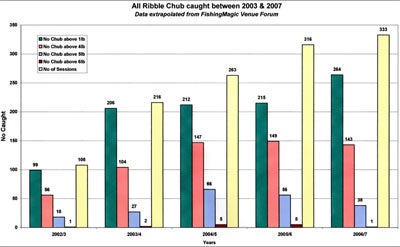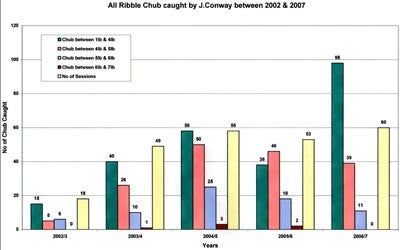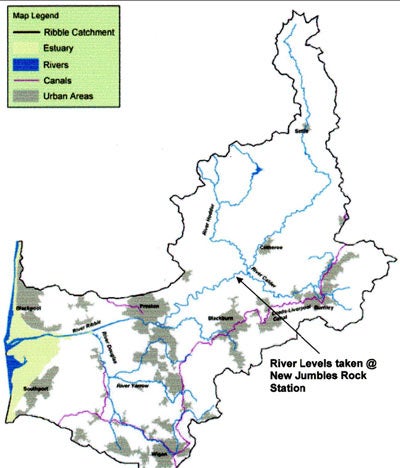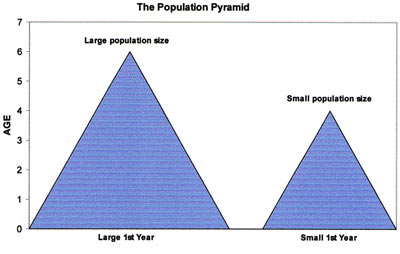A study of Climate Change and its effect on the Chub of the River RibbleAt the end of the 2006/7 coarse fishing season, my Ribble chub records showed that the number of chub caught above 5lb had declined and was still declining into the 2007/8 season. I then extrapolated the corresponding data from the FishingMagic Website Venue Thread for the Ribble and it showed a similar decline in chub caught above 5lb. I then started to think about why this might be, and if by looking at the possible sources of change affecting coarse fishing on the Ribble, I might find an answer. The two graphs below are the starting point of this investigation.
The two bar charts show for each year: – Green: No. of chub above 1lb to 4lb – Pink: No. of chub caught between 4lb & 5lb – Blue: No. of chub caught between 5lb & 6lb – Brown: No. of chub caught above 6lb – Yellow: No. of sessions
The Ribble CatchmentThe River Ribble rises in the Pennines in the Yorkshire Dales at the confluence of Gayle Beck and Cam Beck and its character is that of a typical spate river. However, just below Settle the river passes across a large flood plain, a more typical feature of a lowland river, locally known as Long Preston Deeps, and here the river meanders and twists across open pasture with little or no protection from the elements. It’s also at Settle that the river crosses the Craven Fault and we are out of the open bare limestone hills and into the glaciated valleys of North West Lancashire. The mid Ribble is joined south of Clitheroe by two major tributaries; the Hodder and the Calder. The River Hodder rises in the Forest of Bowland where it is dammed near to its source to form Stocks Reservoir. The River Calder, crossing East Lancashire, contrasts to the Hodder in that it is a post-industrialized river, exhibiting pollution from relics of mining, contaminated land run-off and sewage discharges. From the Calder downriver the Ribble Basin covers a varied landscape shaped by a variety of activities, including livestock farming in the upper catchments to the industrialised urban areas such as Blackburn in the middle catchment. These activities have all had an impact upon the water quality and quantity of the Ribble. Historically, the landscape has also been modified, as watercourses and wetlands were altered to improve land drainage. The river upstream of the confluence with the Calder is predominately a game river, below the Calder, and including the Calder, it is a mixed fishery and it is in this part of the river that the barbel and chub are the main species targeted by the coarse angler.
Fish PopulationsA successful fish population is one that prospers within the limits of its environment. If a water body contains all of the elements needed to satisfy the basic requirements of the fish, then that population is more likely to be successful. In many cases, there will be habitat constraints, predation, competition and disease, as well as variable weather conditions at critical times.
The number of fish surviving their first year of life largely determines their overall contribution to the population. If many fish survive the first year, then that “year class” will be more numerous in later years. The classic “population Pyramid” can be used to illustrate this:
Poor conditions can affect the survival of young fish, and can result in lower numbers being added, or “recruited”, to the adult population.
The above information was extracted from the on-line EA book ‘Coarse Biology & Management’. Climate Change, Temperature, Food, Growth & CompetitionFish are cold blooded or poikilothermic animals and have the capacity to grow continuously all their lives. The growth rate in fish is not constant; it varies during the year and throughout the life cycle of the fish. In general the growth rate of fish is rapid in the first few years and after attainment of maturity gradually declines, ie, growth is continuous but growth rate declines with age. All growth comes from food and the products of ingestion and is either used for the maintenance or growth. Many factors affect the growth rate; food supply, temperature, stress and behaviour, etc. The metabolism of fish is very dependent upon the external temperature. This is particularly relevant in temperate latitudes where minimal growth is recorded during the colder months. The food supply may be adequate at this time but the digestive processes of fish are much slower at these sub optimal temperatures. The growth of fish is thus much more variable and vulnerable to external factors than mammals. The above is a Pr When you purchase through links on our site, we may earn an affiliate commission, which supports our community.
|
Welcome!Log into your account















